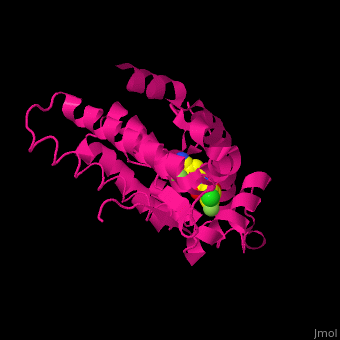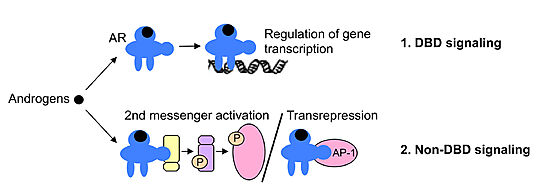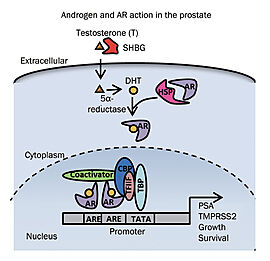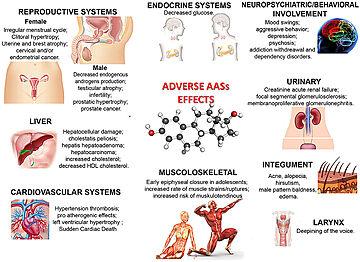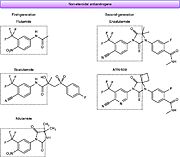Androgen receptor
From Proteopedia
(Difference between revisions)
| Line 68: | Line 68: | ||
==Steroidal Drugs== | ==Steroidal Drugs== | ||
===Natural ligand: Testosterone=== | ===Natural ligand: Testosterone=== | ||
| - | Aging and other factors are associated with a reduction of testosterone levels which could lead to late onset hypogonadism <ref name="hypogonadism">PMID: 32737921</ref>. The decrease of the T levels and therefore its active metabolite levels (DHT) are related with several symptoms such as low libido, erectile dysfunction, skeletal muscular loss <ref name="NR" /><ref name="hypogonadism" />, increased cardiovascular risk <ref name="hypogonadism" />, etc. | + | Aging and other factors are associated with a reduction of testosterone levels which could lead to late onset hypogonadism <ref name="hypogonadism">PMID: 32737921</ref>. The decrease of the T levels and therefore its active metabolite levels (DHT) are related with several symptoms such as low libido, erectile dysfunction, skeletal muscular loss <ref name="NR" /><ref name="hypogonadism" />, increased cardiovascular risk <ref name="hypogonadism" />, etc. Testosterone Restitution Therapy (TRT) is recommended to treat those symptoms, and has been associated with the improvement in sexual function and the increase in muscle mass and bone mineral density <ref name="Testosterone">PMID: 34888506</ref>. |
| - | One of the problems associated with the use of | + | One of the problems associated with the use of testosterone as a therapeutic agent in TRT is the delivery method, tending to have low efficacy when it is administered orally <ref name="NR" /><ref name="SARMs therapy" />. It also has some disadvantages when administered by intramuscular injections or implants <ref name="NR" />. Also, the use of this hormone as a treatment could triggered a lot of AR activity widespread around the body. Long-term exposures to a high dose could lead to related side effects like erythrocytosis <ref name="NR" /><ref name="SARMs therapy" />, dyslipidemia, hepatotoxicity <ref name="SARMs therapy" /> and an increase in cardiovascular risk <ref name="hypogonadism" /><ref name="Testosterone" />. |
| - | Due to all these problems, some institutions like the FDA warn about the safety issues related with this therapy assessing the reduction of its use <ref name="hypogonadism" /><ref name="Testosterone" />. However, other agencies like the EMA supported by the European Academy of Andrology establish the practical use of this therapy in men’s hypogonadism <ref name="hypogonadism" /><ref name="Testosterone" />. So, there is still some controversy about its use, and | + | Due to all these problems, some institutions like the FDA warn about the safety issues related with this therapy assessing the reduction of its use <ref name="hypogonadism" /><ref name="Testosterone" />. However, other agencies like the EMA supported by the European Academy of Andrology establish the practical use of this therapy in men’s hypogonadism <ref name="hypogonadism" /><ref name="Testosterone" />. So, there is still some controversy about its use, and it is currently studied in clinical trials <ref name="Testosterone" />. |
<scene name='89/895670/Cv/6'>Human androgen receptor bound to testosterone</scene> ([[2ylo]]). | <scene name='89/895670/Cv/6'>Human androgen receptor bound to testosterone</scene> ([[2ylo]]). | ||
===Antagonist: Steroid Androgen Receptor Antagonist (ARA)=== | ===Antagonist: Steroid Androgen Receptor Antagonist (ARA)=== | ||
| - | The development of these drugs | + | The development of these drugs was one of the first approaches to treat prostate cancer, targeting AR activity by having a structure with a steroidal skeleton <ref name="ARA prostate" />. |
| - | This kind of antiandrogens have | + | This kind of antiandrogens have affinity to other steroid receptors (glucocorticoids receptor, progesterone receptor…), show low efficacy and cause some side effects like hepatotoxicity and increased cardiovascular risks <ref name="ARA prostate" />. Some examples are cyproterone acetate (CPA) <ref name="ARA prostate" /><ref name="bicalutamide">PMID: 15833816</ref><ref name="nonsteroidal">PMID: 16841196</ref> or megestrol acetate <ref name="ARA prostate" />. |
===Agonist: Anabolic Androgen Steroids (AAs)=== | ===Agonist: Anabolic Androgen Steroids (AAs)=== | ||
'''[[Image:Side effects.jpg | thumb | upright=2.0 | Reproduced from Sessa et al. <ref>PMID: 30524281</ref> ]]''' | '''[[Image:Side effects.jpg | thumb | upright=2.0 | Reproduced from Sessa et al. <ref>PMID: 30524281</ref> ]]''' | ||
| - | These drugs | + | These types of drugs began to be produced in mid-20th century <ref name="Steroids">PMID: 33148520</ref>. They have anabolic activity what improves muscular mass and physical function. However, their uncontrolled use and abuse lead to several side effects like testicular atrophy, alopecia, gynecomastia in the case of males, and clitoral hypertrophy or menstrual irregularities in the case of women. Men and women can experience mood disorders and the chronic abuse could result in a high risk of suffering cardiovascular disease and prostate cancer <ref name="Steroids" />. |
| - | Because of the doping scandals in the athlete community, the World Anti-Doping Agency (WADA) has | + | Because of the doping scandals in the athlete community, the World Anti-Doping Agency (WADA) has banned them <ref name="Steroids" />. This creates the need to discover androgens that have beneficial anabolic activity with reduced androgenic activity. |
==Non-Steroidal Drugs== | ==Non-Steroidal Drugs== | ||
===Selective Androgen Receptor Modulators (SARMs)=== | ===Selective Androgen Receptor Modulators (SARMs)=== | ||
| - | Steroid androgens can be associated with a high rate of adverse effects, which limits their widespread clinical use. | + | Steroid androgens can be associated with a high rate of adverse effects, which limits their widespread clinical use. SARMs were developed to try to overcome these side effects. |
| - | + | SARMs are small molecule drugs that manipulate AR function in different tissues <ref name="SARMs knowledge" />, acting as both agonist and antagonist, with potential to treat AR-related diseases. | |
| - | These non-steroidal drugs | + | These non-steroidal drugs can normally be administered orally or using a transdermal injection <ref name="NR" /><ref name="SARMs therapy" /> with better compliance. They are not affected by 5α-reductase (limiting their androgenic adverse effects) and aromatase (limiting their estrogenic side effects) <ref name="NR" /><ref name="SARMs therapy" />. Those characteristics help to reduce side effects related to the use of natural androgens. Moreover, the tissue selectivity of these drugs make them a suitable option to treat syndromes and diseases skipping the risk related with the use of TRT <ref name="NR" /><ref name="SARMs therapy" /><ref name="SARMs" />. |
| - | Also, some SARMs could be a | + | Also, some SARMs could be a good option to achieve the improvement in anabolic activity and muscular density obtained by the use of AAs, without the unwanted side effects associated with their androgenic action <ref name="Steroids" />. |
| - | ====Mechanism of SARMs==== | + | ====Mechanism of Action of SARMs==== |
| - | Currently | + | Currently, the tissue selectivity of SARMs is still under research <ref name="SARMs" /><ref name="Steroids" /> and there is no consensus in the detailed mechanisms of action. However, there are two features that could explain their biological activity: |
*Their non-steroidal composition and the fact that they are unaffected by 5α-reductase <ref name="SARMs therapy" /><ref name="SARMs" /><ref name="Steroids" />, which promote the interaction of AR with tissue-specific coactivators. | *Their non-steroidal composition and the fact that they are unaffected by 5α-reductase <ref name="SARMs therapy" /><ref name="SARMs" /><ref name="Steroids" />, which promote the interaction of AR with tissue-specific coactivators. | ||
*The way SARMs bind to the AR, which is what primarily enhances or represses their effect. Each SARMs/AR complex has a different conformation and tissues have unique patterns of AR expression, co-regulatory proteins levels and transcriptional regulation <ref name="SARMs knowledge" />. | *The way SARMs bind to the AR, which is what primarily enhances or represses their effect. Each SARMs/AR complex has a different conformation and tissues have unique patterns of AR expression, co-regulatory proteins levels and transcriptional regulation <ref name="SARMs knowledge" />. | ||
| - | When a ligand promotes interactions between the N- and C-terminal AR domains, the AR is | + | When a ligand promotes interactions between the N- and C-terminal AR domains, the AR is fully active. The ability to reduce N/C interactions is the hallmark of SARMs that display antagonisms in androgenic tissues <ref name="SARMs knowledge" />. |
====Diseases that could be treated with SARMs==== | ====Diseases that could be treated with SARMs==== | ||
SARMs may one day play a role in the treatment of cognitive disorders, such as '''Alzheimer's disease'''. Androgens facilitate the reduction of deleterious ß-amyloid (ßA) plaques, upregulating the expression of ßA-degrading neprilysin and promoting synapse formation and neurogenesis, upregulating brain derived neurotrophic factor <ref name="Steroids" />. | SARMs may one day play a role in the treatment of cognitive disorders, such as '''Alzheimer's disease'''. Androgens facilitate the reduction of deleterious ß-amyloid (ßA) plaques, upregulating the expression of ßA-degrading neprilysin and promoting synapse formation and neurogenesis, upregulating brain derived neurotrophic factor <ref name="Steroids" />. | ||
Revision as of 09:31, 29 November 2022
| |||||||||||
References
- ↑ 1.00 1.01 1.02 1.03 1.04 1.05 1.06 1.07 1.08 1.09 1.10 Davey RA, Grossmann M. Androgen Receptor Structure, Function and Biology: From Bench to Bedside. Clin Biochem Rev. 2016 Feb;37(1):3-15. PMID:27057074
- ↑ Kolyvas EA, Caldas C, Kelly K, Ahmad SS. Androgen receptor function and targeted therapeutics across breast cancer subtypes. Breast Cancer Res. 2022 Nov 14;24(1):79. doi: 10.1186/s13058-022-01574-4. PMID:36376977 doi:http://dx.doi.org/10.1186/s13058-022-01574-4
- ↑ 3.00 3.01 3.02 3.03 3.04 3.05 3.06 3.07 3.08 3.09 3.10 Tan MH, Li J, Xu HE, Melcher K, Yong EL. Androgen receptor: structure, role in prostate cancer and drug discovery. Acta Pharmacol Sin. 2015 Jan;36(1):3-23. doi: 10.1038/aps.2014.18. Epub 2014 Jun , 9. PMID:24909511 doi:http://dx.doi.org/10.1038/aps.2014.18
- ↑ 4.0 4.1 4.2 4.3 4.4 4.5 4.6 4.7 Messner EA, Steele TM, Tsamouri MM, Hejazi N, Gao AC, Mudryj M, Ghosh PM. The Androgen Receptor in Prostate Cancer: Effect of Structure, Ligands and Spliced Variants on Therapy. Biomedicines. 2020 Oct 15;8(10):422. doi: 10.3390/biomedicines8100422. PMID:33076388 doi:http://dx.doi.org/10.3390/biomedicines8100422
- ↑ van Royen ME, van Cappellen WA, de Vos C, Houtsmuller AB, Trapman J. Stepwise androgen receptor dimerization. J Cell Sci. 2012 Apr 15;125(Pt 8):1970-9. doi: 10.1242/jcs.096792. Epub 2012 Feb , 10. PMID:22328501 doi:http://dx.doi.org/10.1242/jcs.096792
- ↑ Kono M, Fujii T, Lim B, Karuturi MS, Tripathy D, Ueno NT. Androgen Receptor Function and Androgen Receptor-Targeted Therapies in Breast Cancer: A Review. JAMA Oncol. 2017 Sep 1;3(9):1266-1273. doi: 10.1001/jamaoncol.2016.4975. PMID:28301631 doi:http://dx.doi.org/10.1001/jamaoncol.2016.4975
- ↑ 7.0 7.1 7.2 Gibson DA, Saunders PTK, McEwan IJ. Androgens and androgen receptor: Above and beyond. Mol Cell Endocrinol. 2018 Apr 15;465:1-3. doi: 10.1016/j.mce.2018.02.013. Epub , 2018 Feb 24. PMID:29481861 doi:http://dx.doi.org/10.1016/j.mce.2018.02.013
- ↑ Ceruti JM, Leiros GJ, Balana ME. Androgens and androgen receptor action in skin and hair follicles. Mol Cell Endocrinol. 2018 Apr 15;465:122-133. doi: 10.1016/j.mce.2017.09.009. , Epub 2017 Sep 12. PMID:28912032 doi:http://dx.doi.org/10.1016/j.mce.2017.09.009
- ↑ 9.0 9.1 9.2 9.3 9.4 9.5 9.6 Solomon ZJ, Mirabal JR, Mazur DJ, Kohn TP, Lipshultz LI, Pastuszak AW. Selective Androgen Receptor Modulators: Current Knowledge and Clinical Applications. Sex Med Rev. 2019 Jan;7(1):84-94. doi: 10.1016/j.sxmr.2018.09.006. Epub 2018 Nov , 30. PMID:30503797 doi:http://dx.doi.org/10.1016/j.sxmr.2018.09.006
- ↑ 10.0 10.1 10.2 10.3 10.4 10.5 10.6 10.7 Burris TP, Solt LA, Wang Y, Crumbley C, Banerjee S, Griffett K, Lundasen T, Hughes T, Kojetin DJ. Nuclear receptors and their selective pharmacologic modulators. Pharmacol Rev. 2013 Mar 1;65(2):710-78. doi: 10.1124/pr.112.006833. Print 2013 , Apr. PMID:23457206 doi:http://dx.doi.org/10.1124/pr.112.006833
- ↑ 11.0 11.1 11.2 11.3 11.4 11.5 11.6 11.7 Christiansen AR, Lipshultz LI, Hotaling JM, Pastuszak AW. Selective androgen receptor modulators: the future of androgen therapy? Transl Androl Urol. 2020 Mar;9(Suppl 2):S135-S148. doi: 10.21037/tau.2019.11.02. PMID:32257854 doi:http://dx.doi.org/10.21037/tau.2019.11.02
- ↑ 12.0 12.1 12.2 12.3 Narayanan R, Coss CC, Dalton JT. Development of selective androgen receptor modulators (SARMs). Mol Cell Endocrinol. 2018 Apr 15;465:134-142. doi: 10.1016/j.mce.2017.06.013. , Epub 2017 Jun 15. PMID:28624515 doi:http://dx.doi.org/10.1016/j.mce.2017.06.013
- ↑ Culig Z, Klocker H, Bartsch G, Hobisch A. Androgen receptors in prostate cancer. Endocr Relat Cancer. 2002 Sep;9(3):155-70. doi: 10.1677/erc.0.0090155. PMID:12237244 doi:http://dx.doi.org/10.1677/erc.0.0090155
- ↑ 14.00 14.01 14.02 14.03 14.04 14.05 14.06 14.07 14.08 14.09 14.10 14.11 14.12 14.13 14.14 14.15 14.16 14.17 14.18 Helsen C, Van den Broeck T, Voet A, Prekovic S, Van Poppel H, Joniau S, Claessens F. Androgen receptor antagonists for prostate cancer therapy. Endocr Relat Cancer. 2014 Aug;21(4):T105-18. doi: 10.1530/ERC-13-0545. Epub 2014 , Mar 17. PMID:24639562 doi:http://dx.doi.org/10.1530/ERC-13-0545
- ↑ 15.0 15.1 15.2 15.3 15.4 15.5 Sesti F, Pofi R, Minnetti M, Tenuta M, Gianfrilli D, Isidori AM. Late-onset hypogonadism: Reductio ad absurdum of the cardiovascular risk-benefit of testosterone replacement therapy. Andrology. 2020 Nov;8(6):1614-1627. doi: 10.1111/andr.12876. Epub 2020 Aug 11. PMID:32737921 doi:http://dx.doi.org/10.1111/andr.12876
- ↑ 16.0 16.1 16.2 16.3 16.4 Kaur H, Werstuck GH. The Effect of Testosterone on Cardiovascular Disease and Cardiovascular Risk Factors in Men: A Review of Clinical and Preclinical Data. CJC Open. 2021 May 17;3(10):1238-1248. doi: 10.1016/j.cjco.2021.05.007. , eCollection 2021 Oct. PMID:34888506 doi:http://dx.doi.org/10.1016/j.cjco.2021.05.007
- ↑ 17.0 17.1 17.2 17.3 17.4 17.5 17.6 Bohl CE, Gao W, Miller DD, Bell CE, Dalton JT. Structural basis for antagonism and resistance of bicalutamide in prostate cancer. Proc Natl Acad Sci U S A. 2005 Apr 26;102(17):6201-6. Epub 2005 Apr 15. PMID:15833816
- ↑ 18.0 18.1 18.2 18.3 18.4 Gao W, Kim J, Dalton JT. Pharmacokinetics and pharmacodynamics of nonsteroidal androgen receptor ligands. Pharm Res. 2006 Aug;23(8):1641-58. doi: 10.1007/s11095-006-9024-3. PMID:16841196 doi:http://dx.doi.org/10.1007/s11095-006-9024-3
- ↑ Sessa F, Salerno M, Di Mizio G, Bertozzi G, Messina G, Tomaiuolo B, Pisanelli D, Maglietta F, Ricci P, Pomara C. Anabolic Androgenic Steroids: Searching New Molecular Biomarkers. Front Pharmacol. 2018 Nov 20;9:1321. doi: 10.3389/fphar.2018.01321. eCollection , 2018. PMID:30524281 doi:http://dx.doi.org/10.3389/fphar.2018.01321
- ↑ 20.0 20.1 20.2 20.3 20.4 20.5 20.6 20.7 Machek SB, Cardaci TD, Wilburn DT, Willoughby DS. Considerations, possible contraindications, and potential mechanisms for deleterious effect in recreational and athletic use of selective androgen receptor modulators (SARMs) in lieu of anabolic androgenic steroids: A narrative review. Steroids. 2020 Dec;164:108753. doi: 10.1016/j.steroids.2020.108753. Epub 2020 Oct , 24. PMID:33148520 doi:http://dx.doi.org/10.1016/j.steroids.2020.108753
- ↑ 21.0 21.1 Fonseca GWPD, Dworatzek E, Ebner N, Von Haehling S. Selective androgen receptor modulators (SARMs) as pharmacological treatment for muscle wasting in ongoing clinical trials. Expert Opin Investig Drugs. 2020 Aug;29(8):881-891. doi: , 10.1080/13543784.2020.1777275. Epub 2020 Jun 18. PMID:32476495 doi:http://dx.doi.org/10.1080/13543784.2020.1777275
- ↑ 22.0 22.1 22.2 Masiello D, Cheng S, Bubley GJ, Lu ML, Balk SP. Bicalutamide functions as an androgen receptor antagonist by assembly of a transcriptionally inactive receptor. J Biol Chem. 2002 Jul 19;277(29):26321-6. doi: 10.1074/jbc.M203310200. Epub 2002 , May 15. PMID:12015321 doi:http://dx.doi.org/10.1074/jbc.M203310200
- ↑ 23.0 23.1 Duke CB, Jones A, Bohl CE, Dalton JT, Miller DD. Unexpected Binding Orientation of Bulky-B-Ring Anti-Androgens and Implications for Future Drug Targets. J Med Chem. 2011 Apr 20. PMID:21506597 doi:10.1021/jm2000097
- ↑ 24.0 24.1 24.2 24.3 Fujita K, Nonomura N. Role of Androgen Receptor in Prostate Cancer: A Review. World J Mens Health. 2019 Sep;37(3):288-295. doi: 10.5534/wjmh.180040. Epub 2018 , Sep 10. PMID:30209899 doi:http://dx.doi.org/10.5534/wjmh.180040
- ↑ 25.0 25.1 Leone G, Tucci M, Buttigliero C, Zichi C, Pignataro D, Bironzo P, Vignani F, Scagliotti GV, Di Maio M. Antiandrogen withdrawal syndrome (AAWS) in the treatment of patients with prostate cancer. Endocr Relat Cancer. 2018 Jan;25(1):R1-R9. doi: 10.1530/ERC-17-0355. Epub 2017 , Sep 28. PMID:28971898 doi:http://dx.doi.org/10.1530/ERC-17-0355
- ↑ 26.0 26.1 26.2 26.3 26.4 26.5 26.6 26.7 26.8 26.9 Cavaliere F, Cozzini P. An insight about the mechanism of action (MoA) of R-bicalutamide on the androgen receptor homodimer using molecular dynamic. Toxicol Appl Pharmacol. 2022 Apr 1;440:115953. doi: 10.1016/j.taap.2022.115953. , Epub 2022 Mar 1. PMID:35245614 doi:http://dx.doi.org/10.1016/j.taap.2022.115953
- ↑ Smith MR, Saad F, Chowdhury S, Oudard S, Hadaschik BA, Graff JN, Olmos D, Mainwaring PN, Lee JY, Uemura H, Lopez-Gitlitz A, Trudel GC, Espina BM, Shu Y, Park YC, Rackoff WR, Yu MK, Small EJ. Apalutamide Treatment and Metastasis-free Survival in Prostate Cancer. N Engl J Med. 2018 Apr 12;378(15):1408-1418. doi: 10.1056/NEJMoa1715546. Epub , 2018 Feb 8. PMID:29420164 doi:http://dx.doi.org/10.1056/NEJMoa1715546
- ↑ Pollock Y, Smith MR, Saad F, Chowdhury S, Oudard S, Hadaschik B, Olmos D, Lee JY, Uemura H, Bhaumik A, Londhe A, Rooney B, Brookman-May SD, De Porre P, Mundle SD, Small EJ. Clinical characteristics associated with falls in patients with non-metastatic castration-resistant prostate cancer treated with apalutamide. Prostate Cancer Prostatic Dis. 2022 Oct 8. doi: 10.1038/s41391-022-00592-9. PMID:36209239 doi:http://dx.doi.org/10.1038/s41391-022-00592-9
Proteopedia Page Contributors and Editors (what is this?)
Cristina Benito, Michal Harel, Cristina Murga, Marta Roldan Lazaro, Alexander Berchansky, Joel L. Sussman, Wayne Decatur, David Sánchez Fernández
